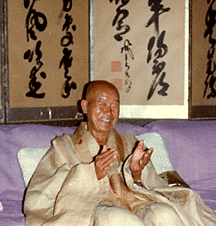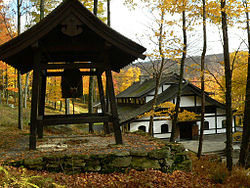User:Mind meal/Sandbox33
Sōen Nakagawa | |
|---|---|
 | |
| Title | Roshi |
| Personal | |
| Born | March 19, 1907 |
| Died | March 11, 1984 (aged 76) |
| Religion | Rinzai |
| Education | Tokyo Imperial University |
| Senior posting | |
| Based in | Ryutakuji |
| Predecessor | Gempo Yamamoto |
| Successor | Eido Tai Shimano (not confirmed) Kyudo Nakagawa Sochu Suzuki Fujimori Kozen |
Sōen Nakagawa (March 19 1907—March 11 1984) was one of the most influential of Japanese Rinzai masters to teach Zen Buddhism in the United States. Sōen was particularly known for his poetry, and throughout life he had retained a special admiration for the haiku poetry of the Zen monk Matsuo Bashō. Known for his maverick personality and his constant questioning of Zen orthodoxy, in 1982 he presented Maurine Stuart with the title of roshi; although Sōen did not officially confer inka to Stuart—this was the first time a female in the United States had been recognized as a roshi in the Rinzai school. It would not be until 1994 that a woman would receive this status in an official capacity, which happened when Roko Sherry Chayat received inka from her teacher Eido Tai Shimano (who is one of five Dharma heirs of Sōen). Sōen's overall influence in shaping Zen practice in the United States was rather extraordinary, with influential teachers such as Philip Kapleau and Robert Baker Aitken having studied under him. He was also a very good friend of Nyogen Senzaki, with whom he carried out many correspondences in life. His Dharma heir, Eido Tai Shimano, considers Sōen to be the founder of Dai Bosatsu Zendo Kongo-ji.
Biography
[edit]
Sōen Nakagawa was born March 19 1907[1] in Iwakuni, Yamaguchi, Japan. His father—an army doctor—died early in Sōen's childhood and his mother never again married.[2] After years of financial struggles living with his mother, Sōen entered Tokyo Imperial University and studied Japanese literature and the work of Matsuo Bashō (graduating in 1930). In 1931 he was ordained as an unsui (novice monk) on his birthday at Kogaku-ji by Katsube Keigaku.[1] During this period he would often spend his days at Dai Bosatsu Mountain in retreat, where he envisioned one day building a monastery. Though this never came to pass, Sōen did consider Dai Bosatsu Zendo Kongo-ji (located in the Catskill Mountains of New York) to be the symbolic equivalent of this vision.[1] Also, during this same period, Sōen began to publish some of his journal writings and poetry in the Japanese magazine Fujin Koron (Woman's Review). In 1934 Nyogen Senzaki, based then in Los Angeles, California, came to read Sōen's writings and was impressed. After, Senzaki initiated a correspondence with Sōen which would blossom into a lifelong friendship between the two men.[2]
In 1936 Sōen had published the first of four books of poems titled Shingan ("Coffin of Poems"). At around this time he also began receiving Zen instruction from Gempo Yamamoto at Ryutakuji. Not long after beginning his training with Yamamoto, Sōen traveled to Dai Bosatsu Mountain for a two year retreat and then returned to Ryutakuji for training again.[2] Then, in 1948 or 1949, Nakagawa came to give a speech at the Theosophical Society of San Francisco at an event arranged by his friend Nyogen Senzaki. According to author Manu Bazzano, "At one point during his talk, he referred to a statement by his friend Soyen Shaku who had said that after 40 years of studying the Dharma he had only begun to grasp the fact that 'after all, I do not understand anything.' He said that the same was true for himself: the audience was disappointed; they just laughed at him."[2][3] Having returned to Japan, in 1950 Nakagawa became Yamamoto's successor at Ryutakuji. Shortly after, Robert Baker Aitken came to Ryutakuji and studied under Sōen for a period of seven months.[4] In 1951 another American student, Philip Kapleau, had also arrived at Ryutakuji—where he stayed for a period of three months.[2] According to Rafe Martin in the Fall 2004 issue of Buddhadharma: The Practitioner's Quarterly, "Roshi Kapleau used to say that if it hadn’t been for that initial generous and warm friendship with Nakagawa Roshi, the talks and travels, the hours they spent listening to recordings of Beethoven together, he might never have been able to stay in Japan or enter Zen at all."[5]
Sometime around 1955, a young Eido Tai Shimano came to Ryutakuji and began training under Sōen. That following year, Nyogen Senzaki made his first and only return trip to Japan—coming to Ryutakuji and meeting with his friend Sōen and leaving a big impression on Shimano. After Senzaki had returned to the United States, and Shimano had matured in his practice, Sōen made plans to send Shimano to America to serve as Senzaki's assistant. Before he was able to send Shimano, however, Senzaki died in 1958.[2][6] However, in 1960 Sōen sent Shimano to the Diamond Sangha in Honolulu, Hawaii to help Robert Baker Aitken and his wife Anne Hopkins Aitken in the running of the center. While there, allegations of misconduct were alleged against Shimano which eventually caused a schism between the Bakers and Sōen (with Shimano returning back to Japan).[2]
In either the 1960s or early 1970s Sōen founded the first Zen center in Israel, known as Kibutsu-ji. According to Lionel Obadia in the Charles S. Prebish and Martin Baumann book Westward Dharma, "Nakagawa sought to legitimize his missionary undertaking by the discovery of a linguistic similarity between the Japanese designation of the center (ki, basis; butsu, Buddha) and the Hebrew word kibbutz (pioneer community form of Jewish settlement). Likewise, Nakagawa's efforts in translating the Zen doctrine to a Jewish audience were facilitated by the phonetic resemblances between Hebrew and Japanese. He even translated Japanese poetry into Hebrew for his Jewish followers based on a similarity between the Hebrew term mut (die) and the Japanese mu (emptiness)."[7]
Character
[edit]One story which demonstrates a side of Sōen's character is told in Peter Matthiessen's book Nine-Headed Dragon River:
|
In addition to his many eccentricities, Sōen Nakagawa was also known to be particularly creative. According to author James Ishmael Ford, "Famously, he was known to conduct tea ceremony using Coca-Cola or instant coffee and occasionally using Styrofoam cups. Nothing was off limits if it would help point the way."[2]
Teaching style
[edit]Trivia
[edit]- Sōen was a big fan of the Broadway musical Fiddler on the Roof.[2]
- He was also known to be a fan of classical music, particularly the works of Beethoven.[5]
Notable students
[edit]
- Eido Tai Shimano
- Kyudo Nakagawa
- John Daido Loori
- Peter Matthiessen
- Paul Reps
- Robert Baker Aitken
- Philip Kapleau
- Maurine Stuart
- Roko Sherry Chayat
- Sochu Suzuki[9]
Bibliography
[edit]- Nakagawa, Sōen (2004). Inochihen. Tōkyō daigaku ryōzenkai kōenkai. ISBN 4831510831.
{{cite book}}: Cite has empty unknown parameter:|coauthors=(help) - Nakagawa, Sōen (2004). Jikku. Tōkyō daigaku ryōzenkai kōenkai. ISBN 4831510823.
{{cite book}}: Cite has empty unknown parameter:|coauthors=(help) - Nakagawa, Sōen (1996). Endless Vow: The Zen path of Sōen Nakagawa. Shambhala Publications. ISBN 1570621624.
{{cite book}}: Unknown parameter|coauthors=ignored (|author=suggested) (help) - Nakagawa, Sōen (1986). The Soen Roku: The Sayings and Doings of Master Soen. Zen Studies Society Press. OCLC 15017366.
{{cite book}}: Cite has empty unknown parameter:|coauthors=(help) - Nakagawa, Sōen (1949). Meihen. Kokudosha, Shōwa 24. OCLC 47935927.
{{cite book}}: Cite has empty unknown parameter:|coauthors=(help)
See also
[edit]Notes
[edit]References
[edit]- Bazzano, Manu (2006). Buddha Is Dead: Nietzsche And the Dawn of European Zen. Sussex Academic Press. ISBN 1845191498.
{{cite book}}: Cite has empty unknown parameter:|coauthors=(help) - Ford, James Ishmael (2006). Zen Master Who?: A Guide to the People and Stories of Zen. Wisdom Publications. ISBN 0861715098.
{{cite book}}: Cite has empty unknown parameter:|coauthors=(help) - Martin, Rafe (Fall 2004). "A Pillar of Zen: Roshi Philip Kapleau 1912 - 2004". Buddhadharma: The Practitioner's Quarterly. Shambhala Sun Foundation. Retrieved 2008-03-14.
{{cite journal}}: Cite has empty unknown parameter:|coauthors=(help) - Matthiessen, Peter (1998). Nine-headed Dragon River: Zen Journals, 1969-1985. Random House. ISBN 0877733252.
{{cite book}}: Cite has empty unknown parameter:|coauthors=(help) - Prebish, Charles S. (2002). Westward Dharma: Buddhism Beyond Asia. University of California Press. ISBN 0520226259.
{{cite book}}: Unknown parameter|coauthors=ignored (|author=suggested) (help) - Prebish, Charles S (1999). Luminous Passage: The Practice and Study of Buddhism in America. University of California Press. ISBN 0520216970.
{{cite book}}: Cite has empty unknown parameter:|coauthors=(help) - Senzaki, Nyogen (2005). Like a Dream, Like a Fantasy: The Zen Teachings and Translations of Nyogen Senzaki. Wisdom Publications. ISBN 0861712803.
{{cite book}}: Unknown parameter|coauthors=ignored (|author=suggested) (help) - Shimano, Eido Tai (May/June 1984). "Soen Roshi" (PDF). Zen Notes. 31 (5). First Zen Institute of America. Retrieved 2008-03-13.
{{cite journal}}: Check date values in:|date=(help); Cite has empty unknown parameter:|coauthors=(help) - Snelling, John (1987). The Buddhist Handbook. Century, an imprint of Random House. ISBN 0712615547.
{{cite book}}: Cite has empty unknown parameter:|coauthors=(help)
